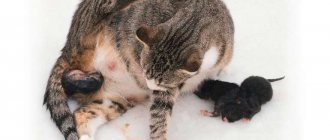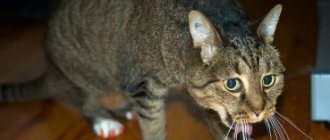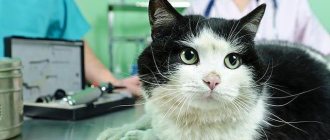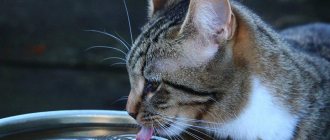At approximately 1.5 years of age, the young cat is fully grown and mature, has had its first exhibitions and is ready to become a mother. At this point, every breeder needs to stop and take a sober look at things. Is your cat a valuable, breeding member of the breed? Will kittens be in demand? If not, then forget about mating. There are too many abandoned animals on the streets now. But of course, this does not apply to purebred, breeding cats. After all, titles acquired at an exhibition allow you to choose the same thoroughbred partner and get excellent offspring.
Why does a cat still “flow” after mating?
In fact, everything is natural and natural. Usually, for several hours and even days after coitus, the female will behave restlessly, still purring, rolling on the floor and lifting her tail when any touch to the rump.
The phenomenon is explained simply: during estrus, a huge amount of sex hormones are released into the blood, and it takes some time for the body to adjust to its normal mode. Ovulation occurs somewhere 24-36 hours after intercourse, it is quite logical that the animal will still be in heat for at least a day and then it will take another 2-3 days for all the accompanying symptoms to subside.
Sexual viability
The ability to reproduce in representatives of the cat family is called sexual maturity. Females reach this state by 6-8 months, males - 4-5 weeks later. The sexual hunt begins: “girls” go into heat, and “boys” have an increase in testosterone levels, which is manifested by increased aggression and marking of territory.
However, the time has not yet come for the first mating at such a “tender” age. Risk factors for premature mating include:
- slower growth and development;
- deterioration in appearance;
- complications of pregnancy and childbirth;
- the birth of weak or stillborn babies;
- the threat of infertility (for “girls”) and impotence (for “boys”).
For romantic dates, you need to wait for structural formation, physiological and psychological maturity. The optimal age of a cat for the first mating is 14-15 months. At this point, Murka is going through 2-3 heats.
It’s also not worth delaying fertilization. You can’t let your pussy stay “in the girls” for too long. Owners who delay untying their pet for up to one and a half years should be aware of the possible consequences for its health:
- polycystic disease;
- inflammation of the uterus;
- false pregnancies;
- stress;
- exhaustion.
“Grooms” are physiologically ready to perform reproductive functions at the age of 12-13 months.
The first time a cat is in heat: is it possible to breed
A cat's first heat can occur without obvious symptoms, that is, it can be invisible to the owner. The cat, although physiologically ready to become pregnant, has not yet fully reached the physical state of an adult.
The first heat is not an indicator of the possibility of mating. Pregnancy at a very young age (up to 1 year) can be harmful to the health of the animal. Also, due to incomplete development, stillborn kittens may be born, and complications of pregnancy and childbirth are possible.
It is important to prepare the first mating, the cat’s “marriage,” in advance.
After mating, the cat vomits, diarrhea, does she have a fever?
Such symptoms, although quite rare, do occur. Why is this happening?
- Consequences of stress: change of environment, rampant hormones, etc.
- Stomach upset as a result of a sudden change in food, if the owners of the female for some reason forgot to transfer the usual food to the temporary place of residence.
- Food poisoning, poisoning, which are in no way related to cages, but are a coincidence of two phenomena in time.
Very rarely, if cat owners are negligent about vaccination, a cat can pick up a pathogenic virus in someone else’s home. There have been cases when, after mating, a female became infected with calcivirosis, rhinotracheitis, panleukopenia, rhintotracheitis, etc.
That is why it is so important to check the breeder’s veterinary passport before mating and inquire about the vaccinations given. Even a healthy-looking cat, which is full of strength and energy, can turn out to be an “incubator” (a carrier of the virus) and transmit a terrible and dangerous disease to its lover. By the way, cat owners should also not forget about preventive vaccination.
Solving problem situations
In the affairs of amorous animals, not everything goes smoothly. In some cases, a couple needs help from:
- The cat hisses at the cat when mating. There is no need to rush animals, especially inexperienced ones. They need more time for foreplay.
- The cat is smaller in size than its partner, as a result of which the cat rests on its back. In this case, it is necessary to send the male.
- The bride falls on her side during sexual intercourse. In such a situation, they support the female.
We suggest you read: What to feed a castrated cat with natural food. Feeding a cat after castration: features of natural and industrial nutrition
False pregnancy after mating
False pregnancy is harmful to the cat. Unlike dogs, false pregnancies do not occur as often in cats. Its occurrence is preceded by sterile sexual intercourse, that is, when the reproducer has some problems with the seminal fluid, for example:
- low sperm motility;
- complete absence of “little creatures” due to frequent use or inflammation;
- pathological forms of male cells or their non-viability.
Like a normal pregnancy, a false pregnancy is accompanied by:
A sterilized cat asks for a cat: 4 reasons
There are the following causes of estrus in sterilized females:
- Incomplete removal of epididymal tissue. Occurs when an unremoved piece of ovarian or epididymal tissue remains, which is capable of regenerating and partially replacing the internal secretion organ. Estrus occurs as usual, but pregnancy does not occur and the pet will not be able to bring kittens. Repeated surgery, as a rule, does not solve the problem. Not every veterinarian is able to find the criminal piece of tissue, and repeated anesthesia will harm the cat’s health. However, the chance of achieving a positive result increases if the uterus and surrounding tissue are removed.
- Development of the reminant ovary. After the removal of the reproductive organs, the pituitary gland or adrenal glands begin to produce sex hormones. Statistics show that one out of seven castrated cats can retain the ability to secrete estrogen.
- Congenital anomaly. Cells of the ovarian appendages take root in other organs.
- Development of a hormone-like tumor. The neoplasm has the ability to secrete estrogens. Pathology is observed in cats that were castrated in adulthood.
Be sure to read: How to care for a cat after sterilization: blanket, diet, treatment and removal of sutures
What to do if a pregnant cat calls for a cat
Opinions on this matter are mixed; some are convinced that if a cat asks for a cat, then she is not pregnant. But how can we explain this behavior of a pet if she is really pregnant and this fact is confirmed by ultrasound.
If the cat is not mated, estrus continues for 7-14 days, and then a new cycle begins. If the female has been mated, estrus repeats every 2-3 months.
It should be noted that cats in heat rarely experience any bleeding, although there is mucous discharge that is not always noticeable. If an animal has bloody discharge, you should be wary. This sign may indicate the presence of a serious disease, for example, pyometra.
If the female is mated, it is not a fact that she is pregnant. A false pregnancy can continue for a month with signs of pregnancy appearing, for example, mammary glands may swell and food preferences may change.
Even in late pregnancy, resorption of the fetus can occur, and as a result, miscarriage. This can happen if environmental conditions are unfavorable (hot summer, smoke from fires) and the body, in defense, gets rid of the fruits. After a miscarriage, the cat may ask for a male cat.
During the first week (7 days) after mating, the egg is fertilized and moves to the uterus. The ability to fertilize is still preserved, and the female can seek the attention of the cat. If another mating occurs during this period, then it can also be successful; there is still time for the eggs to be fertilized by the male’s sperm.
If the cat is truly pregnant but asks for a male cat, then there is a small chance of returning to heat between the 3rd and 6th week of pregnancy. With the onset of a new heat, even if the cat is pregnant, instinct tells her to look for a partner to mate with. Typically, such individuals have a reduced level of progesterone, the hormone responsible for preparing the female’s body for pregnancy. Hormonal imbalance during pregnancy signals the body that there is no pregnancy.
During this period, although rarely, the female can mate. As a result of this mating, the cat bears kittens from the first mating and additional kittens from the second mating, and the fathers may be different. This phenomenon is called superfetation. The nurse will simultaneously give birth to full-term kittens from the first mating and premature, non-viable kittens from the second mating, or she will give birth to healthy kittens from the first mating and then, over time, “give birth” to full-term kittens from the second mating.
Repeated mating should not be allowed if it is not planned (control mating), especially if the pet is clearly pregnant. The female and male should be separated into different rooms, or the male should be sterilized (castrated) if there is no purpose of using him for breeding.
In some cases, mating during pregnancy can lead to serious consequences, including miscarriage and death of the animal.
If a pregnant pet exhibits changes in behavior characteristic of a female in heat, it is recommended to consult a veterinarian, primarily to identify pathologies and determine pregnancy.
Mating a cat with a cat
The cat asks for the cat
Unfortunately, binge drinking after sterilization cannot always be avoided. Cases when a female walks after sterilization are rare, but they do occur. A cat asks for a cat after surgery only as a result of the following factors:
- Poor quality sterilization;
- Hormonal duplication;
- Ectopic ovarian tissue syndrome.
The manifestation of signs of heat and the appearance of estrus is mainly characteristic of females that have been operated on already in adulthood. She walks because the animal’s hormonal background changes significantly after the operation.
Soon after sterilization, it is quite possible that primary signs of estrus will appear and she will most likely ask for a male cat again.
Should there be discharge after mating?
This is where it’s worth going into more detail. The fact is that discharge from the genitals after mating in cats is normal in some cases, but in others it is a very serious signal that there is a pathology in the body.
Usually, another 2-3 days after the cage, you can observe transparent, watery mucus - this is the norm and the result of a still ongoing estrus. This phenomenon should not bother owners.
But the appearance of dirty, brown, viscous discharge mixed with blood and an unpleasant odor is a very bad and unfavorable symptom. What it could mean:
- abortion;
- sexual infection;
- inflammatory processes in the reproductive organs (gynecological diseases).
Abortion can occur at longer periods or just a few days after mating. He can wear:
- infectious etiology, the same sexually transmitted infections (brucellosis, chlamydia, toxoplasmosis, plague);
- and non-contagious, when there are abnormalities of intrauterine development, endocrine disorders (reduced secretion of progesterone), intoxication, the use of drugs that affect the functioning of smooth muscles, various injuries or hypothermia.
With different types of abortion there will be different signs. You can indirectly judge an impending miscarriage by the appearance of dark green discharge mixed with blood. In any case, consultation with a specialist and pelvic ultrasound are necessary to make a diagnosis.
Gynecological diseases arise as a result of the influence of various factors, in particular secondary microflora. Opportunistic microorganisms present both on the male penis and in the female vagina are the cause of opportunistic infections that lead to inflammatory processes in the reproductive organs.
For a healthy animal, the presence of these microbes does not pose any danger. If a cat has microtraumas on the reproductive organs, immunity is reduced, then the natural defense weakens, “foreign” bacteria transmitted by the cat during sexual intercourse begin to multiply rapidly, leading to diseases such as vaginitis, metritis, pyometra, endometritis, oophoritis and etc.
In most cases, gynecological diseases are accompanied by discharge and subsequent pregnancy failure, if it occurs at all. Therefore, it is so important to carry out periodic examinations before mating, to treat the animal in a timely manner for any inflammation, in order to be confident in the health of the pet and her ability to bear healthy offspring.
When to start mating
When does a cat start asking for a cat? The answer depends entirely on the physiology of the pet. In practice, females can bear offspring approximately once every six months. The first estrus begins 7-8 months after birth. But it's not that simple.
Depending on the individual characteristics of the body, it can begin much later or even earlier. In any case, it is almost impossible to control the process .
A cat can scream and ask for a cat, oddly enough, at any time of the year. The best time to bear kittens is between the cat's 2nd and 5th birthday. In theory, a female can give birth for up to 10 years. But after the 7th year, frequent anomalies in the development of the offspring are observed, and the likelihood of miscarriage increases. Therefore, the best period for the first pregnancy will be the third heat.
ATTENTION! If a young purr is too timid and cautious, then it is better to mate with an experienced gentleman. As a rule, the female does not allow the cat to approach her for some time. Up to several days
You probably won't be able to get pregnant right away. Potential partners should be introduced. It will take several meetings for the future parents to get to know each other better. Meetings don't have to be long. The maximum travel time is limited to an hour. It is better to focus on the frequency of meetings rather than the duration.
It is important to note that the cat must feel like he is in charge of the situation. It is better if the mating takes place on his territory. During the period of acquaintance, he can actively mark his territory. If a cat is taken to a cat to mate, then he definitely needs to get comfortable. The owners of the female will have to endure forced inconveniences in the form of fur, yelling and active arrangement of the guest in the apartment.
The mating room should be spacious and bright. It is advisable not to disturb partners during the meeting and remove other animals and children from the premises. Cats can be extremely shy. Such caution can greatly affect the mating and reduce it to nothing.
Several matings can occur between partners (up to 10), but this does not guarantee that the female will become pregnant, even if the cat is absolutely healthy
What other cases are there?
The signal that the female is ready for mating is estrus. How do you know if your pussy has started sexual intercourse? She experiences obvious “languor”:
- purrs often and loudly;
- fawns or turns into an aggressive touch-me-not;
- rubs vigorously against all sorts of objects;
- takes a characteristic pose when stroking the back: the trembling tail is pulled to the side, the rear is raised, the chest falls to the floor.
The “lady” is sent to the “gentleman” on the third day after such signs appear. The guest comes with her things: food, bowls, litter tray. No one knows how long it will take to breed a cat and a cat. You need to plan for 1-3 days. The first time it may take a week.
Pairing
During estrus, the female makes special sounds, purrs and crouches to the floor. When she is located towards her partner, she takes a special pose, arches her back and moves her tail. The male holds her by the withers with his teeth and covers her. Sexual intercourse lasts several seconds. If this is your first mating, then it will be important to find out in advance how the cat behaves after mating. She pushes the cat away, makes characteristic high-pitched screams, begins to lick herself furiously and demonstrates her reluctance to continue communication. In some cases, she may show aggression and attack. In others it is simply secluded. Sometimes owners wonder why the cat tumbles after mating. There is no exact answer, perhaps the male bit her scruff too hard.
There is no need to be afraid of such behavior. The cat behaves this way after mating not because she is in pain. It’s just that nature very wisely doses the sexual desire of females. In this case, it has fulfilled its function, and repeated sexual intercourse will become possible only after some time. Usually, in order for pregnancy to occur with a 99% probability, cats are bred three times, on the second or third day of ovulation. Another option is to allow animals to mate during the three most favorable days of estrus.
How should a cat behave after mating?
There is no clear answer to this question. Each animal is an individual with its own quirks, temperament, and physical development.
Some cats can hide in a corner and lie there for several days with an indifferent look or just sleep. Perhaps it is stress from experienced emotions or simple fatigue. Screams for many days, endless intercourse make themselves felt, and the body requires rest. If the cat is sad, but otherwise everything is fine: she eats, drinks water, goes to the toilet and does not have a temperature, then there is no reason to worry.
Other ladies have an increased appetite, which in principle is also natural. The answer is still the same: the body restores energy lost during sexual games and accumulates new energy for bearing offspring.
Sex Barrier is the most humane and suitable method for a breeder to calm a pet
As mentioned earlier, it is better for a cat to give birth no more than three times every two years. This will prevent her from being depleted and give her the opportunity to live a full life.
To relieve tension and desire, the Sex Barrier recommended by veterinarians is used. This remedy completely removes all negative manifestations of “desire” in cats.
Its use will provide:
- regulation (delay) of the onset of “hunting” in a cat;
- contraceptive effect (within 24 hours from the time of use);
- decrease in sexual arousal and its negative manifestations: animal screams, “marking” of territory, nervous or angry behavior, the desire to run away from the apartment.
Mating of cats is a sensitive process, and although the sexual act itself lasts no more than a few minutes, the stage of introducing partners and exploring the territory can take a long time. Representatives of the cat world who live on the street differ in this - the search for a male cat suitable for an act of love takes only a few hours.
Sections
- cat diseases Hypersalivation (increased salivation) in cats
- If your cat drinks a lot of liquid
- Constipation in cats
- Diseases of the urinary system
- Diseases of the reproductive system in cats
- Uterine prolapse and hernia in cats
- Poor growth and hair loss
- cat nose
- Respiratory tract infections in cats
- Diseases of cats with inflammation of the oral cavity
- Poor appetite in cats
- Treatment of diarrhea in a cat
- Diseases of the nervous system in cats
- How to castrate cats and female cats
- Obesity in domestic cats and kittens
- Cat skin and its derivatives
- Tumors
- Feline eye diseases
- Causes and ways to eliminate bad breath in cats
- Digestive system of a cat
- Causes of vomiting in cats
- Kidney diseases
- Respiratory system diseases in cats
- Cannibalism and other pathologies in cats during childbirth
- Feline skin diseases
- Cat's eyes
- Discharge from the eyes and nose in cats
- Games and communication with cats
- British white cat
- Giardia in cats
- Cat character and its types
- Can a cat be friends with other animals?
- Signs of illness in cats
- Arranging a cattery by sector
- How to feed a cat and how to accustom it to new food?
- Communication of British cats
- Burmese cat
- Veterinary control
- Growth and development of kittens
- How to care for a cat's fur
Under optimal conditions, a cat can give birth twice a year.
It doesn't depend on the time of year. You can knit her only when she is healthy and in good physical shape. A cat gives birth until she is 8-10 years old. Maximum fertility in this biological species occurs at 2-5 years. An animal over 7 years old has irregular sexual cycles, a high chance of giving birth to kittens with abnormalities and the threat of miscarriage. In individuals younger than one year old, the same problems are observed. A weak sexual instinct is also added to them. It is advisable to use cats that have reached full maturity for breeding. This not only allows you to get healthy offspring, but also does not put the mother’s life in danger.
Age
Young animals often behave timidly or completely refuse to mate. A shy cat is best bred with an experienced partner. It is better to introduce the female to the breeder gradually so that they get used to each other. Let them be together for 15 minutes every day. In the future, increase the time of communication. It is better to mate an inexperienced cat with an experienced and non-aggressive male.
We recommend reading: What is the Body Temperature of Dogs
During the first mating, inexperienced cats may forever give up the joys of love if the female behaves very aggressively. Choose your partner responsibly.
Mating conditions
It is advisable to bring a cat to a cat, but not vice versa. This is necessary for the male to feel confident in his territory. External factors can interfere with mating. It is important for cats to mark their territory. If the owner washes the tags or uses perfume, the male may refuse to approach the cat. Until he completely marks the entire territory. And this takes up to 10 days!
When mating, animals should have plenty of room to play. The nursery often has a separate room.
During heat, only allow one cat near your cat. When mating with several, the litter may contain kittens from different males. DNA testing is sometimes required to determine paternity.
Moving can have a negative impact on your cat's well-being. Sometimes this leads to hormonal dysfunction. The cycle may stop altogether. Bring your cat to the cat a few weeks before her heat so that she has time to get used to the new place.
Mating progress
During estrus, the female makes peculiar sounds and purrs. To mate, she takes a special position: she crouches to the ground, arches her back and moves her tail to the side. After some foreplay, the cat covers the female, holding her by the withers with his teeth. Within a few minutes, the male settles on the cat, squeezing its sides with his paws.
The sexual act itself lasts a few seconds. When it is completed, the cat moves away from the cat and emits a characteristic cry. After coitus, the animal may show aggression towards the male. Let him have the opportunity to run and hide. The mating room should be spacious with a vertical rise.
The cat will roll around furiously on the floor and then begin to lick itself. Especially the genital area. Most cats refuse to have intercourse again. It turns out that this happens again only 3-7 times.
You need to understand that a cat also has preferences in choosing a partner. She will agree to mate with one cat, but will “reject” the others. It often happens that animals of one breed do not like others. If a cat has become accustomed to a particular male, it is not a fact that she will mate with him again.
It is effective to mate a female three times a day on the second or third day of the cycle. In this case, ovulation will occur with a 90% probability. Another effective method is to allow animals to mate for short periods on all three days of estrus.
Sometimes the female turns on her side during mating. To make the cat more comfortable, you can hold the cat by the neck. Be careful, animals can be aggressive towards the third wheel! Perhaps an obstinate cat should not be used for breeding.
When mating, animals should have plenty of room to play. The nursery often has a separate room.
At approximately 1.5 years of age, the young cat is fully grown and mature, has had its first exhibitions and is ready to become a mother. At this point, every breeder needs to stop and take a sober look at things. Is your cat a valuable, breeding member of the breed? Will kittens be in demand? If not, then forget about mating. There are too many abandoned animals on the streets now. But of course, this does not apply to purebred, breeding cats. After all, titles acquired at an exhibition allow you to choose the same thoroughbred partner and get excellent offspring.
The cat is limping, crying in pain, won’t sit on its butt – what is this?
First of all, it is necessary to examine the female for bites and deep scratches. Cats, in the heat of passion, grab the bride by the back of her head, neck, and scruff with their teeth, scratching her in order to hold her in place during coitus. This is why all breeders recommend trimming their pets’ nails before breeding in order to somehow minimize injuries.
In the article about mating it was already written that you should not organize a meeting between two virgins, otherwise injuries cannot be avoided. Inexperienced animals can adapt to each other for a long time, the cat does not succeed, but at the same time he is not able to lose his long-awaited sexual partner and holds her by all possible means (teeth and claws).
It is quite possible that the couple was disturbed during boarding, they jerked in surprise, fell off somewhere and the cat could have damaged something.
The problems described above are the most common. If you have any additions or questions, write them in the comments, and your opinion will not go unnoticed.
KotoDigest Thank you for subscribing, check your inbox: you should receive an email asking you to confirm your subscription
First contact requirements
A partner for a meowing ward is found in advance. They look through advertisements, go to exhibitions, prepare their pet for the decisive meeting.
Rules for mating cats:
- To avoid dangerous pathologies, estrus cannot be stopped with hormonal or other drugs.
- The first mating of cats requires a fully completed vaccination plan (4 weeks must pass after the last immunization).
- Half a month before intercourse, deworming is carried out.
- On the day of the meeting, the “bride” (as well as the “groom”) have their claws trimmed to avoid injury.
- It is wrong to bathe cats before mating: soap and shampoos muffle the smell of pheromones.
- At the crucial hour, they make sure that the female is moderately well-fed, well-groomed, with clean ears, clear eyes, and a shiny nose.
Mating a cat and its conditions:
- The breeder is supposed to be healthy, vaccinated, treated for worms, and externally well-groomed.
- To stimulate sexual activity, it is recommended to enrich the menu with B vitamins a couple of days before intimacy.
- The cat owner, as the owner of the “mating station”, is obliged to ensure that the meeting is successful: organize an acquaintance, competently stimulate the development of sexual relations, and be responsible for the comfort and safety of the furry guest.
The meeting of a pair of virgins is undesirable. It is fraught with psychological or physical damage.
What you need to know
When purchasing a cat, you must decide in advance whether you will share it with a cat or not.
If you want to breed a cat, then you do not need to give her drugs that suppress sexual heat, as this is fraught with complications. At first glance, these are harmless drugs, but they can cause serious hormonal changes in the animal’s body and disrupt all sexual function. Because of these drugs, estrus may become irregular or disappear altogether for quite a long time. When mating cats that have received anti-estrus pills, their behavior is extremely aggressive, which leads to the fact that the animal simply remains uncovered.
For cats that are supposedly able to be “safely mated,” unfortunately, not everything goes smoothly either, since after mating the cat remains empty, and after a certain time the cat begins to go into heat again.
It is extremely difficult to establish hormonal balance after such drugs; in addition, the drugs can cause quite serious health problems in the animal. Therefore, if you do not want kittens, it is best to sterilize the cat.
Causes for concern
Sometimes owners sound the alarm when a cat, after mating, begins to behave as if she is sick. This is often accompanied by diarrhea or vomiting, and sometimes the temperature rises. There are several explanations for this:
- pronounced reaction to stress (presence of a male or moving, change in hormonal levels, etc.);
- digestive disorders due to a change in diet, if the animal was given to another home for mating without the usual food;
- the onset of toxic infection is possible, which is not associated with attempts to have offspring;
- bacterial or viral infection for which the male has not been vaccinated (calcivirosis, rhinotracheitis, panleukopenia, etc.).
Signs about a cat in bed
In the old days, overly caring owners were warned: “Whoever sleeps in the same bed with a cat will get frogs in his head!” Of course, it is impossible to treat this sign without humor, and it was invented, most likely, only in order to instill in people at least some concept of hygiene. A mouse hunter freely roaming through courtyards and garbage dumps could bring into bed such an infection that would make frogs seem like a cute thing. But nowadays the problem of hygiene is not so acute, many pets are desperate homebodies, and therefore the question of whether to allow the animal to sleep in the bed depends only on you. It remains to find out how signs explain a cat’s choice of a place to sleep.
At the owner's feet
- Esotericists claim that negativity accumulates primarily in the lower part of the body. If an animal settles down to sleep at the feet, it cleanses the owner’s aura and removes the excess that has accumulated during the day.
- Supporters of “mystical-realistic” explanations are sure: in this way the cat relieves fatigue or an incipient illness from the owner. If your beloved Murzik has made a habit of lying on your feet every evening, take the time to stop by the doctor. Varicose veins are such a common phenomenon these days that it doesn’t hurt to get checked once again.
Around the head
- Feline specialists (experts in cat psychology and habits) say that the animal’s choice of the head of the bed indicates its attachment to its owner. That is, a cat can settle down at the feet simply because it seems warmer there than on the floor. But if she chooses her head, it means she trusts you, loves you and wants to take care of you.
- If we are talking about a woman, the animal could be attracted by the pleasant smell of the shampoo with which the owner washes her hair. It is difficult to please the tastes of a four-legged pet, since your cosmetics will definitely not contain the smell of valerian or sausage. But sometimes unexpected whims occur in cats too.
- Finally, the cat may feel the onset of a migraine, pressure or fever and come to the rescue of the owner. Do not immediately dismiss the “ambulance”, even if you are not inclined to believe in the healing abilities of animals. But what if.
We recommend reading: Duration of eclampsia in dogs
But it’s better not to let the cat on your face
Some people believe that a cat climbs onto a person’s chest or rolls under a barrel when it senses its owner’s bad mood. If your pet settles down on your chest, do not rush to throw the animal onto the floor with dissatisfaction. Perhaps they have come to conduct a psychotherapy session with you!
On the stomach
- The first reason is still the same: illness. It’s certainly too early to run to the doctor the next day after your cat takes a nap on your stomach. But if Murzik didn’t have such a habit before, and now he clings to you every now and then and doesn’t want to leave, you should take care of your health. Cats sense the slightest changes in temperature and love warmth very much - it’s not for nothing that they doze with such pleasure on sunny windowsills and working computers! If an inflammatory process has begun in the stomach, the body temperature will rise, and your pet will quickly notice this. At the very least, listen to your feelings so as not to miss a possible illness.
- The second reason applies exclusively to women. It is in this unexpected way that cats react to their mistress’s pregnancy. Often even before the woman herself knows about her situation! There is no need to be afraid of this. If the animal is healthy, does not give you any unpleasant sensations, does not put pressure on your stomach, it will not cause trouble.
Did you know that cats served as the very first pregnancy tests? To find out whether the long-awaited event had happened or whether the first-born would have to wait a long time, the young wife put the domestic cat on her stomach and watched how it behaved. If you curl up in a ball and doze off, you can begin to prepare for the baby's arrival.
Affectionate purring calms both mother and baby in her belly
Under the bed
Picky cats are no match for obedient and unpretentious dogs. They sleep on rugs under the bed “out of their status.” If the capricious woman nevertheless chooses this particular place to sleep, it means that it is marked by strong energy flows. And this is where the differences in interpretation begin.
- Some people warn to place the bed in the “cat’s bedroom” area. They say that what is only beneficial for the pet is pure harm for its owner, and therefore one should stay away from such places.
- Others believe that the fluffy resident will work as a kind of filter: it will draw out and destroy all negative turbulence, and leave you to enjoy pure, uncomplicated energy for the benefit of your health and mood.
You can judge for yourself who is right. All you need to do is sit down and remember how you feel after sleeping on this bed? If you are cheerful and full of energy, everything is fine. If you feel overwhelmed and tired, as if you are carrying sacks of grain at night, try rearranging your bedroom. And here's an additional reason to play designer: psychologists say that such changes are good for your mood.
Adult cats prefer a sedate lifestyle, but even the laziest four-legged cats are active for 15–20 minutes at a time. Riding on your back is an excellent warm-up for the muscles of the back and neck, which, by the way, almost never relax in cats.
Most owners believe that after mating, the cat will stop screaming demandingly, rolling on the floor, will successfully become pregnant, will successfully carry it to term, and will give birth to active, healthy kittens. We hasten to assure them: not everything is as rosy as it seems. Owners often encounter difficulties after mating their beloved pet with a stud cat. And if the latter, having done the deed, pushes away the “mistress”, goes home and continues to lead his usual way of life, then the cat, like its owner, still has a long and difficult path ahead. Some of the elements of a pet’s behavior after intercourse will seem unusual and even frightening to the owners, but will be within the norm, while others may indicate the development of a pathological process. So how does a cat behave after mating and what do its actions mean?
How does a cat behave after mating?











